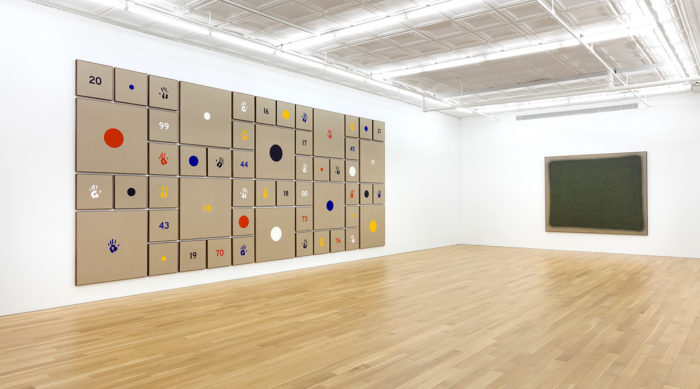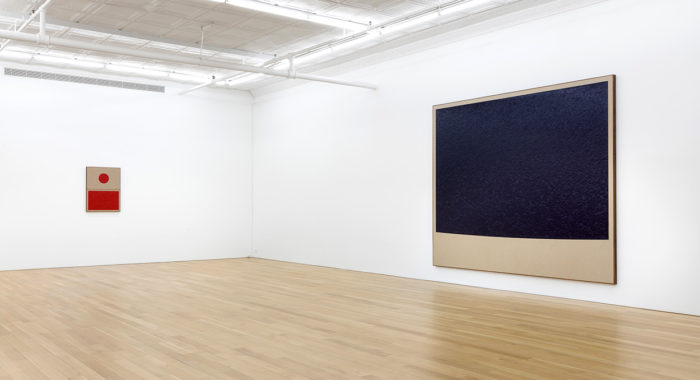
Swedish-born, Brooklyn-based painter Paul Fägerskiöld is the third of three generations of painters in his family–his grandfather was and his father is active in the field–a long, distinguished personal history. The number of his paintings in the large gallery space is small, only four in number, with one very large work: 42nd Parallel Symphony (2008-19), whose dimensions are 117 by 275 inches. The other three are more moderate in size. The title of the show is called “Flatlands.” In literature, Victorian writer Edward Abbott wrote a novel by the same name in 1884, which examined society while making use of spatial dimensions–people were seen and experienced as flat, caught up within the confines of two dimensions. Fägerskiöld employs the novel to structure his own work, which consists of flat geometric shapes on linen. At the same time, the title suggests our current, nearly ideological penchant for material truthfulness in art, in which the illusion of perspective is erased in favor of a technical transparency emphasizing paint as paint, and the essentially flush nature of painting.

Even so, 42nd Street Parallel Symphony is at least as much about painting history as it is about painting itself. Consisting of 54 separate canvases, brought together so that the overall composition is a single rectangle, the painting coheres marvelously well. The smaller canvases example circles, red, black, white, or yellow in color; numbers referencing either personal or art historical events; and handprints in red, yellow, blue, or white. The circles of differing hues punctuate and, to a degree, structure the painting, while the handprints, Fägerskiöld’s own, personalize a painting that is oriented toward the historical awareness, as made evident in the only seemingly random numbers occupying more than a few of the elements of the painting–for example, the number “76” refers to German artist Blinky Palermo’s important sequence, “To the People of New York City,” achieved in 1976. The number (08) refers to the year Fägerskiöld first came to New York. Additionally, the work’s grid-like arrangement generally can be likened to the late art of Mondrian, whose intersecting lines of small, colored squares, as in Broadway Boogie-Woogie, capture the spirit of New York in a way not so dissimilar from Fägerskiöld’s project, grandly conceived as the title indicates. Thus, the painting’s schematic, historical bias is made eloquent by random conjunctions of imagery that align with modern and early contemporary painting in New York.

The 79-by-94-inch acrylic painting, simply entitled _, (2019), results from Fägerskiöld’s use of spray paint, with the nozzle angled so that the paint is spat out rather than delivered in a continuous fog. The result, thousands of small flecks of colored paint on a very dark background, possesses a texture that adds to the physical reality of the painting. Fägerskiöld is nothing if not an abstract artist; he also remains concerned with both the surface of the painting as well as the method by which that surface is achieved. We can only imagine the circumstances of the making of _, (2019), which refers to a very, very recent origin. Likely, the mysterious manner in which the painting was made makes the work attractive in undisclosed ways. Flatland (2019), like _, (2019) a large painting at 98 by 120 inches, refers both to the show’s title and the Victorian novel, but it is mainly about the act of painting. Painted entirely in many layers of dark blue, Flatland does not wholly exclude texture: its surface is made up of tight whorls of paint, painted closely next to each other. The painting’s method does raise the pigment above the surface, despite the intimation of the title. It is a homage to the tradition of the New York School, its emphasis on paint for its own sake, which is both everything and nothing more.

At 34 by 25 1/4 inches, Impression, Harvest Moon (2019) is the smallest work in the group. The painting is divided in half–in the upper part, a red circle is found by itself while the lower part consists of lightly textured red paint. As with all the works in the show, in particular, the three most recently mentioned, Fägerskiöld is most concerned with the act of painting, aligned with but finally separate from the painting history he acknowledges in the large work of art. In doing so, he actually moves from homage to evidencing something new–a very difficult achievement in current art practice, especially within the style of painting he works in. In painting generally, we are in the troubling position of finding precedents all around us–precedents that constrain innovation. But Fägerskiöld, an excellent artist, has produced in this show a small body of work that both acknowledges and transcends the past. In all the arts now–fine art, poetry, music–we find ourselves bound by historicism. But that doesn’t mean we have to succumb to the past. Fägerskiöld makes that very clear in this very accomplished exhibition.
Paul Fägerskiöld: Flatlands at Peter Blum Gallery
March 22 – May 11, 2019
at 176 Grand Street, New York, NY
